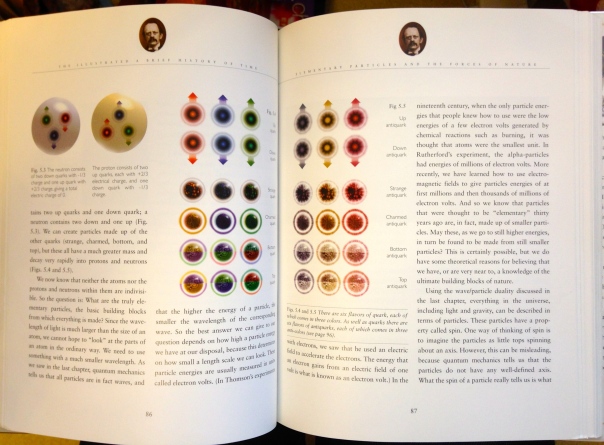Beautifully illustrated.
248 pages, ★★★★
I love physics. I love the mysteries at the frontier of physics and the mind-boggling quantum and relativistic strangeness that happens at very large and very small scales. I’m also an admirer of Stephen Hawking—mostly for his ability to convey science in such a clear, lucid way, but also for his ability to inspire millions of children into developing a love of physics. His books, iPad apps, films and lectures have inspired millions of young people into science.
This book is no exception.
The highlight of this book is when he explains the Hawking radiation that’s emitted from the event horizons of black holes with low mass. Hawking radiation was calculated from the principle that particles and antiparticles, as pairs, pop in and out of existence all the time, even in a vacuum. They appear, then quickly collide again and annihilate each other. Therefore, if an antiparticle appears on one side of an event horizon, and its partner particle appears on the other, then even if there’s only a tiny distance between them, one of the particles could be emitted into space while the other gets drawn into the black hole. The event horizon thus emits a tiny amount of radiation while the black hole gains mass. Fascinating!
I love the illustrations in this book. They’re as clear as my favourite Chemistry textbook by Whitten et al. (reviewed here) and as informative as one of my favourite history textbooks: Quick Access to Chinese History. Here are two of my favourite pages (the graphic conclusion and the double-page spread on subatomic particles).
The only downfall is in the penultimate chapter, when Stephen Hawking discusses the consequences of a deflating universe (as opposed to an inflating universe, which we live in). Hawking predicts that events would happen backwards, and takes the illustrations to the extreme. He says (and illustrates) that buildings would un-demolish themselves and that people would age backwards because the universe’s entropy needs to decrease. Personally, I think that if the second law of thermodynamics were to be reversed, I don’t think that the universe spontaneously reversing human demolition is the most efficient means of decreasing entropy. (A more efficient means might be to aggregate sub-atomic particles of a similar type—resulting in less entropy but more “mess” from a human perspective.) For me, this chapter was conjecture.
Overall, this book is a fascinating read. It engages young readers as well as adults, and conveys information in a clear, graphical way. Recommended for anyone starting to study physics. ★★★★



I agree with you on the “downfall”. Especially this –> (resulting in less entropy but more “mess” from a human perspective). Our ‘psychological arrow of time’ is based on what we have seen and observed since birth.
I specifically didn’t like when he said “the psychological arrow of time is therefore determined within our brain by the thermodynamic arrow of time”. Our brain is much more ..flexible, and NOT controlled by a physics law!
LikeLiked by 1 person